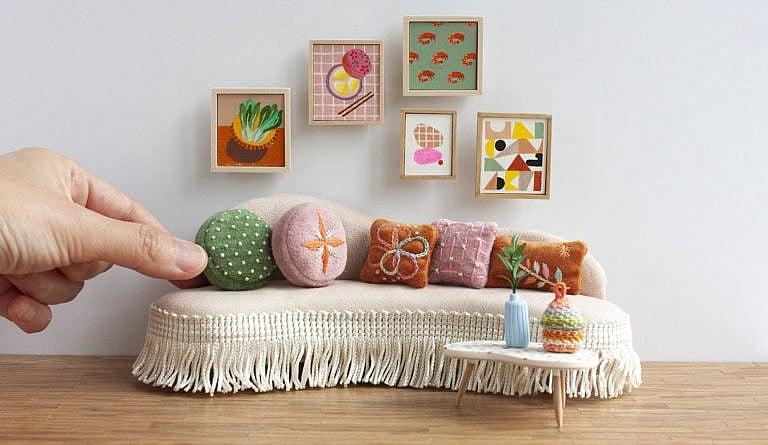How miniaturists are making tiny design dreams come true
Inside the dopamine-inducing subculture of marvellously micro spaces

Photography by Wei Xu
Share
Like so many city-dwelling renters, artist Wei Xu was bored of the plain walls she was unable to paint in her Toronto apartment. She daydreamed of millennial pink paired with emerald-green velvet, and having enough space for a swanky sofa. Her arrangement did not allow modifications to the space, and its measurements were just as constraining.
In a city where the average semi-detached costs over a million, buying property was out of the question. But Xu realized she could still make her design dreams come true. In 2017, she began constructing her own home—in miniature. She purchased a small wooden house-shaped cubby hole from the dollar store and spent hours hand-painting mat board so its back wall would resemble wallpaper. Then came the lighting—a bright LED with a coin cell battery—and floors, made from popsicle sticks she stained herself. Ten days later she was deep in the details, creating tiny houseplant figurines and macramé wall hangings. Her final touch was a chair made of polymer clay, accented with a cross-stitched throw pillow the size of a postage stamp.

The unveiling was a hit on social media, especially among followers who related to Xu’s spatial frustrations. (She says her audience grew exponentially when she started making mini houseplants.) “It’s meant to teleport you into the space and feel its vibes, since not everyone has the space or circumstances to set up their own boho reading space irl,” wrote Xu when she revealed the miniature room on Instagram. “I certainly don’t have the right space for growing lush plants.”
For those without the assets to secure life-size splendour, miniatures satisfy an aesthetic longing. In the Instagram age, miniaturists have developed their own subculture. Ardent makers create signature styles for fans to admire, and for more serious collectors to purchase. Other fans just like to scroll through countless pages of miniatures, enjoying the dopamine-inducing novelty of everyday places and things rendered in 1:12 scale.
"It's a perfect little world that you have total control over."
The Instagram page Daily Mini shares miniatures from around the world with its audience of 228,000 followers, who gush with comments like “resuscitate me.” This praise was directed at Kristine Hanna, an Ottawa-based miniaturist who built a printer with a teensy slice of paper sliding out of the tray. Canadian company Much Love, Harry & Co. focuses on feasts, selling nearly nanoscopic charcuterie boards to collectors. They recently added caviar, made of clay, to the menu. The Italian miniaturist Katia Corsaro specializes in fancy cakes, adorned with icing-esque roses, offered whole or by the slice. And the Japanese artist Miyuki Kobayashi handcrafts miniature aquariums, with tiny fish suspended as though swimming.
The phenomenon even landed its own reality competition show, CBC’s Best in Miniature. A contestant named Kat explained miniatures as “something that brings me into another world, and allows me to afford things that in real life I can’t possibly afford now.” Among Kat’s miniature creations was a bar cart carrying bottles of champagne. One of her competitors, Phillip, trotted out a tiny Eames chair.
Constructing intricate pieces by hand allows Xu to love a living space while reconsidering what makes a home. “Creating your own miniature world is a fun and healthy form of escapism for a lot of people. You can create this perfect little world that you have total control over, which may not be the case for other elements of your life,” she says. As more and more Canadians accept the impossibility of home ownership, miniatures keep the dream of contentment alive, writ small.


What started as a crafting experiment became a full-time pursuit for Xu. In 2019, she quit her marketing job to make miniatures as a career, selling her creations through an online shop. To craft them, Xu toils away in her small home studio, storing equipment in a closet when it’s not in use to preserve precious space.
Xu describes her process as meditative. During the holidays, she made Christmas trees, with handpainted presents and ornaments, which took about a week. She’s also created fully functional miniature credenzas, with shelving and drawers inside; a writing desk with books, a globe and a drawer containing a calculator; and bedroom scenes complete with a pair of slippers on the rug.
Last February, Xu replicated a millennial favourite light-green kitchen cart stocked with cereal boxes and pantry items, and even a wooden spoon and a whisk. Her latest obsession: miniature room dividers. “These really shift the mood,” wrote Xu on Instagram, her thumb pictured arranging a mid-century-modern armchair between a snake plant and a fiddle leaf fig. (The snake plant is just over an inch tall, and she has a monstera that’s about two inches high.)


Most young people are struggling to expand their living space. But in miniature culture, the goal is to shrink. “Doing smaller and smaller details is a challenge. You keep pushing,” says Xu. In her micro but marvellous world, alongside a speckled terrazzo table, an impressive art collection and a stylish vase of greenery, Xu can have that swanky sofa after all.
This article appears in print in the September 2022 issue of Maclean’s magazine. Subscribe to the monthly print magazine here, or buy the issue online here.
